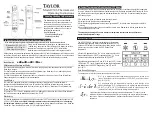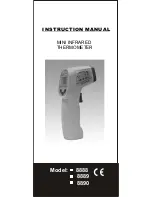
PRESENTATION
- Thermostat Radio Fréquence (868
Mhz), spécialement conçu pour
contrôler différentes installations de
chauffage
Confort
La température de consigne (ajustée
sur la mollette de réglage) sera
maintenue indéfiniment.
OFF
Utiliser ce mode si vous désirez
arrêter la zone gérée par votre
thermostat.
VOYANT d’ETAT
Rouge
(régulation sur sonde interne)
Indicateur de chauffe (quelques
secondes après le réglage de la
consigne)
Orange
(Régulation sur sonde externe)
Indicateur de chauffe (en mode réglage
de consigne uniquement)
Vert clignotant
Transmission de signal RF.
Rouge Clignotant
Indication piles faible. (Généralement
visible apes une transmission RF)
Cycle de 0.5sec => défaut sur la sonde
interne
Cycle de 1sec => défaut sur la sonde
externe
* Si les piles de votre thermostat ont
besoin d’être remplacées, changez
toujours les 2 piles en même temps.
PRESENTATION
-
Radio Frequency “RF” thermostat (433,92 Mhz)
specially designed for water floor heating managed by
actuators.
- Equipped with a switch to select 3 different operating
modes:
Comfort
The setting temperature (adjusted on the knob) will
be followed all the time.
Reduced
The reduced temperature will be followed all the time
(setting temperature - 2°C)
OFF
Use this mode if you need to switch off the zone
managed by the thermostat.
TECHNICAL CHARACTERISTICS
Measured temperature
precision
0.1°C
Operating temperature
0°C - 50°C
Setting temperature
range
1 to 5 (with comfort
temperature on position 3)
Regulation
characteristics
Proportional band 15min for
2°K (PWM)
Electrical Protection
Class II - IP30
Power Supply
Battery operated life
2 x 3V (CR2430)
~ 2 years
Radio frequency
433.92 MHz, <10mW.
Norms and
homologation:
Your thermostat has been
designed in conformity
with the following
standards or other
normative documents:
EN 60730-1 : 2003
EN 61000-6-1 : 2002
EN 61000-6-3 : 2004
EN 61000-4-2 : 2001
EN300220-1/2
EN301489-1/3
R&TTE 1999/5/EC
Low voltage 2006/95/CE
EMC 2004/108/CE
Soft version
V 2.0x
Room
setting.
Select
mode.
LED Indicator.
Batteries
-
PRESENTATION
-
Radio Frequency “RF” thermostat
(868 Mhz) specially designed to
control different type of heating
systems.
Comfort
The setting temperature (adjusted
on the knob) will be followed all the
time.
OFF
Use this mode if you need to switch
off the zone managed by the
thermostat.
LED INDICATOR
Red
(Internal Sensor regulation)
Heating indication (few sec after
consign adjustment)
Orange
(External Sensor regulation)
Heating indication (During consign
adjustment)
Green blinking
Radio Frequency transmission.
Red Blinking
Low batteries indication. (Generally
visible after a RF transmission)
0.5 sec cycle => Internal sensor
failure
1 sec cycle
=> External sensor
failure
* When the batteries must be
replaced, always exchange the 2
batteries in the same time.
BT-A RF
GB
BT-A RF
CONFIGURATION „RF“
o
Tout d’abord positionnez
l’interrupteur de mode de votre
thermostat sur la position
OFF
.
o
Ensuite (*), mettez votre
récepteur en mode “
RF init
”.
(Reportez vous à la notice du
récepteur pour cette opération)
o
Sur le thermostat, basculez
l’interrupteur de mode sur la
position Confort
.
- Vous pouvez maintenant faire un
test de portée pour être sûr de
l’installation. Dans la pièce où doit se
trouver le thermostat, placez le à
l’endroit où il sera positionné plus
tard (sur un meuble ou fixé au mur).
Réglez la consigne courante sur la
position Maxi (35°C), Fermez les
portes et allez vérifier la bonne
réception (le récepteur doit être en
chauffe Led Rouge à 1).
- Retournez au thermostat et
mettez-le maintenant en position
arrêt, vérifiez que le récepteur est
aussi passé en arrêt (Led rouge à
0)
o
Si la réception des signaux
thermostat est correcte,
ajustez votre température de
confort comme vous le désirez
o
Si la réception des signaux
thermostats ne se fait pas
correctement, essayez de
rapprocher le thermostat du
récepteur, vérifiez
l’installation
du récepteur (reportez vous à
la partie Problèmes et solution)
* Pour une initialisation RF maîtrisée
il est préférable d’avoir le récepteur à
portée de vue lors de l’initialisation
(distance minimale > 1Mètre)
F
ALLGEMEINES
- BT Funk-Raumthermostat (868 MHz)
zur Einzelraumregelung, in
Verbindung mit BT Funk-
Regelverteilern.
Komfortbetrieb / EIN
Es wird permanent auf die (mittels
Einstellknopf) eingestellte
Temperatur geregelt.
AUS
Wählen Sie diese Betriebsart, um
den vom Thermostat kontrollierten
Bereich abzuschalten.
STATUS-ANZEIGE
Konstant Rot
Heizbetrieb
Steuerung über internen Raumfühler
(für einige Sekunden nach Einstellung
Solltemperatur)
Konstant Orange
Heizbetrieb
Steuerung über externen Fühler
(für einige Sekunden nach Einstellung
Solltemperatur)
LED blinkt grün
Funkübertragung.
LED blinkt rot
Die Batterien sind schwach bzw. leer.
(Erscheint in der Regel im Anschluss
an die Funkübertragung).
0,5 Sekunden Intervall => Störung des
internen Fühlers
1 Sekunde Intervall => Störung des
externen Fühlers
* Bitte wechseln Sie bei einem
Batteriewechsel immer beide
Batterien.
FUNK-KONFIGURATION
Betriebswahlschalter am
Thermostat auf OFF (AUS) stellen.
Anschließend (*) BT-Funk-
Regelverteiler gemäß Anleitung in
Funk-Konfigurationsmodus bringen.
(Details siehe Anleitung BT-Funk-
Regelverteiler).
Betriebswahlschalter des
Thermostats auf Komfortbetrieb
stellen.
- Sie können nun die Funkdistanz
prüfen, indem Sie in den Raum
gehen, dessen Temperatur reguliert
werden soll. Bringen Sie den
Thermostat in seine endgültige
Position (an der Wand oder auf einem
Tisch ...), und stellen Sie am
Thermostat die Betriebsart
„Komfort“
(Temperatur von 35°C) ein. Schließen
Sie die Tür, und überprüfen Sie am
Empfänger, ob dieser den neuen
Status des Thermostats empfangen
hat (Der Heizvorgang wird in der
Regel durch eine rot leuchtende LED
angezeigt).
- Gehen Sie nun wieder zum
Thermostat, und schalten Sie ihn aus.
Überprüfen Sie wieder am
Empfänger, ob dieser ebenfalls
abgeschaltet hat. (Die rote LED muss
aus sein.)
o
Wenn das Funksignal korrekt
empfangen wurde, legen Sie
die gewünschte Solltemperatur
fest.
o
Wenn das Funksignal nicht
korrekt empfangen wurden,
überprüfen Sie die Installation
(Position des Empfängers,
Distanz…)
* Zur Erleichterung der Installation
sollte sich der Thermostat, solange er
im Konfigurationsmodus ist, beim BT-
Funk-Regelverteiler befinden. (Dabei
ist ein Mindestabstand von ca.1 Meter
einzuhalten.)
BT-A RF
D
E
LED
Indicator.
Select
mode.
Room
setting.
„RF“ CONFIGURATION
First of all, switch the button
mode of the thermostat in OFF
position.
To learn (*) the RF thermostat
with the receiver you must put
the receiver in “
RF init
” mode
(please refer to the receiver
leaflet).
Once, on the thermostat switch
the button mode on the comfort
position.
- Now you can check the RF
distance, go to the room which
must be regulated. Put your
thermostat on the final position (On
the wall or table...), then put the
thermostat in Comfort mode
(setting temperature position
35°C). Close the door and go to the
receiver to check if the new status
of the thermostat has received.
(The heating is generally showed
by a Red LED).
- Now return to the thermostat and
switch off it. Check on the receiver
again if it’s also switched off (The
red LED must be turned off)
o
If the RF signals were
received correctly, adjust
your setting temperature as
you want.
o
If the RF signals weren’t
received correctly, check the
installation (Receiver
position, distance...)
* To make the installation easier it
will be better to have the
thermostat near to the receiver
during the configuration mode. (A
minimal distance of > 1meter must
be respected)
TECHNICAL CHARACTERISTICS
Environmental:
Operating temperature:
Shipping and storage temperature:
0°C
– 50°C
-10°C to +50°C
Electrical Protection
IP30 Class II
Setting temperature range
5°C to 35°C
Regulation characteristics
Proportional Band
(PWM 2°C for 10min cycle)
Power Supply
Operating life
2 AAA LR03 1.5V Alkaline
~2 years
Sensing elements:
Internal & External (option)
NTC 10k
at 25°C
Radio Frequency
868 MHz, <10mW.
Norms and homologation:
Your thermostat has been
designed in conformity with the
following standards or other
normative documents:
EN 60730-1 : 2003
EN 61000-6-1 : 2002
EN 61000-6-3 : 2004
EN 61000-4-2 : 2001
EN300220-1/2
EN301489-1/3
R&TTE 1999/5/EC
Low voltage 2006/95/CE
EMC 2004/108/CE
Voyant d’état
Sélecteur de
mode.
Température
de confort
CARACTERISTIQUES TECHNIQUES
Environnent. (Températures)
Fonctionnement:
Transport et stockage :
0°C - 50°C
-10°C à +50°C
Protection électrique
IP30 Class II
Plage de réglage de la
température ambiante
5°C à 35°C
Caractéristiques de régulations
Bande proportionnelle
2°C pour un cycle de 10min
Alimentation
Autonomie
2piles alkaline AAA LR03 1.5V
~2 ans
Elements optionnels:
Sonde interne ou externe
10k ohms à 25°C
Radio Fréquence
868 MHz, <10mW.
Normes et homologation:
Votre thermostat a été conçu pour
répondre aux normes et directives
européennes suivantes:
EN 60730-1 : 2003
EN 61000-6-1 : 2002
EN 61000-6-3 : 2004
EN 61000-4-2 : 2001
EN300220-1/2
EN301489-1/3
R&TTE 1999/5/EC
Basse tension 2006/95/CE
CEM 2004/108/CE
Einstellung
Solltemperatur
LED
Leuchte
EIN / AUS
Schalter
TECHNISCHE DATEN
Umgebungsbedingungen:
Betriebstemperatur:
Transport- und
Lagertemperatur:
0°C - 50°C
-10°C bis +50°C
Schutzart
IP30 Class II
Einstellbereich
Raumtemperatur
5°C bis 35°C
Regelverhalten
Proportionalbereich (PWM
2 °C bei 10-min-Zyklus)
Stromversorgung
Lebensdauer
2 x AAA (Micro) 1.5V
~2 Jahre
Sensor-Elemente:
Intern und extern (Option)
NTC 10k Ohm bei 25°C
Funkfrequenz
868 MHz, <10mW.
Normen und Zulassungen:
Ihr Thermostat wurde in
Übereinstimmung mit den
folgenden Normen oder anderen
normativen Dokumenten
konzipiert:
EN 60730-1 : 2003
EN 61000-6-1 : 2002
EN 61000-6-3 : 2004
EN 61000-4-2 : 2001
EN300220-1/2
EN301489-1/3
R&TTE 1999/5/EC
Niederspannung 2006/95/CE
EMC 2004/108/CE
PPLIMP13664 Aa
ОПИСАНИЕ
Комнатный радиотермостат (868
M
Гц) серии ВТ предназначен для
температурного регулирования в
напольных системах отопления.
Комфортный режим / ВКЛ
Термостат поддерживает в посто-
янном режиме установленную (на
рукоятке) температуру в помеще-
нии.
Выключение / ОFF
При установке выключателя в
нижнее положение, термостат и
контроллируемые им контуры
отопления отключаются.
ПОКАЗАНИЯ СВЕТОДИОДА
Красный постоянный.
Нагрев
Управление по встроенному датчику
(
в течении нескольких секунд после
установки температуры).
Оранжевый постоянный.
Нагрев
Управление по внешнему датчику
(в течении нескольких секунд после
установки температуры).
Зеленый мигающий
Передача радиосигнала
Красный мигающий
Слабые или севшие батарейки (по-
является как правило после переда-
чи радиосигнала).
Интервал 0,5 секунды => сбой
встроенного датчика.
Интервал 1 секунда => сбой
встроенного датчика.
* Вегда заменяйте обе батарейки
одновременно.
РАДИОИНИЦИАЛИЗАЦИЯ
(установка связи с модулем)
Выключите теромостат (нижнее
положение переключателя).
Перейдите в режим инициализа-
ции на коммутирующем модуле (*)
серии ВТ (см. инструкцию модуля).
Переведите термостат в комфор-
тный режим
.
-
Проверьте качество приема моду-
лем радиосигнала. Для этого пере-
несите термостат на место предпо-
лагаемого монтажа (стена, стол) и
установите в комфортном режиме
температуру 35°C. Закройте дверь в
помещение и проверьте, получил ли
радиомодуль сигнал от термостата
(при получении трeбования нагрева
светодиоды зон, связанных с тер-
мостатом, горят красным цветом).
-
Выключите термостат. Проверьте
cнова радиомодуль (диоды соот-
ветствующих зон модуля должны
погаснуть).
o
Если радиомуль получил сигнал,
то инициализация термостата бы-
ла проведена правильно. Устано-
вите на термостате комфортную
температуру.
o
Если радиомодуль не принимает
корректно сигналы термостата, то
возможно он расположен вне ра-
диуса действия сигнала. Проверь-
те правильность подключения ан-
тенны, расстояния между радиo-
модулем и термостатом).
* В течении процесса инициализа-
ции термостат должен находиться в
непосредственной близости от ком-
мутирующего модуля (расстояние
ок. 1м).
* Термостаты серии ВТ совместимы
только с коммутирующими модуля-
ми серии ВТ.
ВНЕШНИЙ ДАТЧИК (опция)
Внешний датчик подключается к
выключенному термостату. При
включении термостат автомати-
чески распознает подключенный к
нему датчик (при подключении вне-
шнего датчика, управления осущес-
твляется только по нему).
BT-A RF
RU
Ручка
установки
температуры
Светодиод
Выключатель
вкл. – выкл.
ТЕХНИЧЕСКИЕ ДАННЫЕ
Температура окружающей
среды и рабочая температура:
Температура
транспортировки и хранения:
0°C - 50°C
-10°C - +50°C
Защита:
IP30
класс II
Диапазон регулирования:
5°C - 35°C
Тип регулирования
ПИ регулирование
(PWM, 2 C
цикл 10 минут)
Питание
Срок работы
2 x AAA
батарейки (Micro) 1.5В
~2
года
Температурные датчики:
Встроенный и внешний (опция)
NTC 10k
Ом при 25°C
Частота радиосигнала
868 МГц, <10мВт.
Соответствие нормам
Ваш термостат разработан в со-
ответствии
со
следующими
стандартами и нормативны-ми
документами
EN 60730-1 : 2003
EN 61000-6-1 : 2002
EN 61000-6-3 : 2004
EN 61000-4-2 : 2001
EN300220-1/2
EN301489-1/3
R&TTE 1999/5/EC
EMC 2004/108/CE
(электромагнитная
совместимость)






















